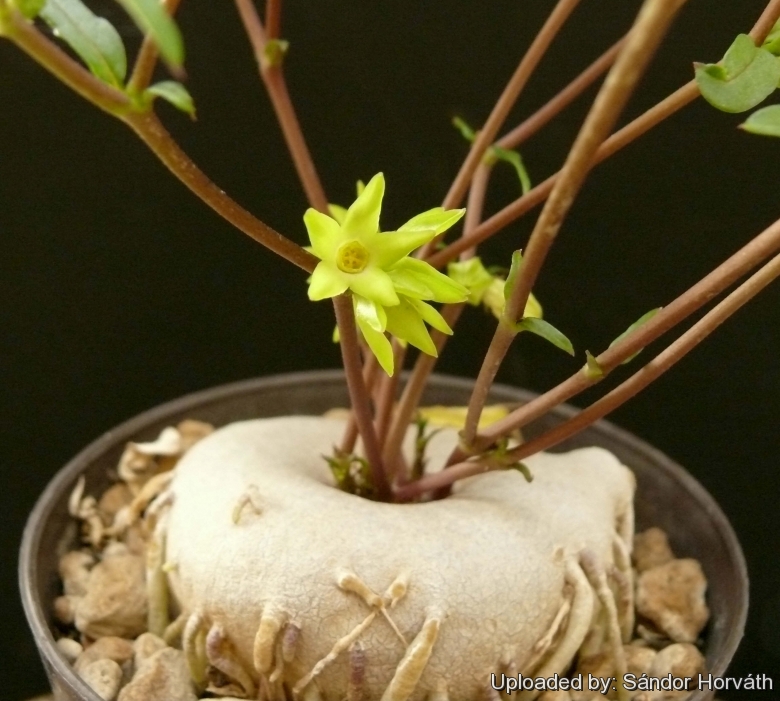




Your support is critical to our success.
- Encyclopedia of SUCCULENTS
- Encyclopedia Index
- Families
- Genera
- Species
- Asclepiadaceae
- Brachystelma
- Caudiciforms
Since 4 Aug 2013

Origin and Habitat: South Africa, KwaZulu-Natal,,Range: Coastal Maputaland, Sodwana Bay to Manzengwenya. Brachystelma vahrmeijeri is a range-restricted species (Extent of occurrence less than 500 km²), known from fewer than five locations.
Habitat and Ecology: Indian Ocean Coastal Belt. This species grows in coastal and woody grasslands, on sandy soils. It continues to decline due to ongoing habitat loss and degradation as a result of subsistence agriculture, forestry plantations and overgrazing. Natural hybridisation is noted occasionally in Brachystelma, hybrids between B. vahrmeijeri and Brachystelma tenue have been seen in the coastal sandveld of the northern Kwazulu-Natal coastal belt.
Synonyms:
- Brachystelma vahrmeijeri R.A.Dyer
Description: Brachystelma vahrmeijeriSN|32314]]SN|32314]] grows several pinkish brown stems from a flat, red tuber (caudex) 5-10 cm in diameter, the top of which may sometimes be seen above ground. The leaf is elliptic to lanceolate with a tapering tip and base. They attenuate into the stems, making the existence of petioles a matter of opinion. The pale yellow star-shaped flowers are widely opened, the corolla lobes often curving either backwards or forwards. This dwarf species does not appear to have a close affinity with any described species.
Derivation of specific name: This species was named after the Dutch-born economic botanist Mr. Johannes Vahrmeijer (1942), settling in RSA in 1950.
Tuber: Round flattened, up to about 10 cm in tall and slightly compressed from above and
below, often with slightly bowl-shaped central area, producing several simple or branched pinkish brown stems up to about 10 cm high, or taller under cultivation, more or less hairy, minutely pubescent or glabrescent.
Leaves: Opposite, with entire margins, elliptic-lanceolate, up to 3 cm long and 7 mm broad, the lowest smaller, glabrous on upper and lower surfaces, sometimes remotely and minutely ciliate on margin, contracted into a short petiole or subsessile.
Inflorescence: Extra axillary, almost sessile, partly collected in whorls at the nodes with two to three flowers in each branch, the oldest topmost and opening in sequence. Pedicels 5-10 mm long. Bracts short linear-lanceolate.
Flowers: Calyx glabrous with sepals linearlanceolate to lanceolate, c. 2.5 mm long. Corolla glabrous, yellowish-green or cream, seldom white or somewhat maroon, 8 mm long. Corolla tube 3 mm long, funnel-shaped, 4 mm across. Corolla lobes fleshy, ovate-triangular, spreading, 5 mm long, 2.5 mm wide. Corona slightly exceeding the base of the staminal column. Outer corona dome-shaped approx. 1 mm high and 1.5 mm in diameter, doubly as high as the staminal column, 10-notched or subentire, with few long hairs within. Inner corona-lobes arising linear-oblong, incumbent on back of filaments but not as long. Pollinia about 0.25 mm diameter somewhat pyriform, compressed. Connectives short, carrier wingless.
Bibliography: Major references and further lectures
1) R. A. Dyer “Notes on the Genus Brachystelma” Bothalia 10, 2 : 373-378 1971
2) Craib, C. 1993. “Field studies and cultivation of some Brachystelma species in the eastern Cape, Natal, the eastern Free State (including Qua Qua), and the Transvaal.” Excelsa 16:11-23.
3) J.P. Roux “Flora of South Africa”, 2003
4) Judd Kirkel “Brachystelma vahrmeijeri” - Operation Wildflower <http://www.operationwildflower.org.za/index.php/component/joomgallery/brachystelmas/brachystelma-vahrmeijeri-judd-1-1760> web 12 January 2016
5) Hilton-Taylor, C. 1996. “Red data list of southern African plants”. Strelitzia 4. South African National Botanical Institute, Pretoria.
6) Urs Eggli, Leonard E. Newton “Etymological Dictionary of Succulent Plant Names” Springer Science & Business Media, 29 June 2013
7) Raimondo, D., von Staden, L., Foden, W., Victor, J.E., Helme, N.A., Turner, R.C., Kamundi, D.A. and Manyama, P.A. 2009. “Red List of South African Plants”. Strelitzia 25. South African National Biodiversity Institute, Pretoria.
8) Scott-Shaw, C.R. 1999. “Rare and threatened plants of KwaZulu-Natal and neighbouring regions.” KwaZulu-Natal Nature Conservation Service, Pietermaritzburg.
9) Victor, J.E. & Peckover, R. 2005. “Brachystelma vahrmeijeri R.A.Dyer.” National Assessment: Red List of South African Plants version 2015.1. Accessed on 2016/01/12
Cultivation and Propagation: In cultivation the plants are usually grown in semi shade, with the tubers wholly or (preferably) partially exposed to prevent scorching and rotting of the roots. This plant can take a good deal of water during active growth and should be watered only when not dormant. Keep dryish in winter. It should be overwintered in the greenhouse at temperatures over 15°C (avoid letting temperatures drop lower than 10° C). Use a very draining but rich soil. An error in cultivation may produce unsightly holes in the tuber.
Reproduction: This species can be reproduced by seeds. Sow seeds in summer in a well drained medium.
| Your Actions | |
|---|---|
| Back to Brachystelma index | |
| Back to Asclepiadaceae index | |
 |
Back to Succulents Encyclopedia index |
Privacy stantement - Terms and conditions - How to cite - About us - Feedback - Donate



